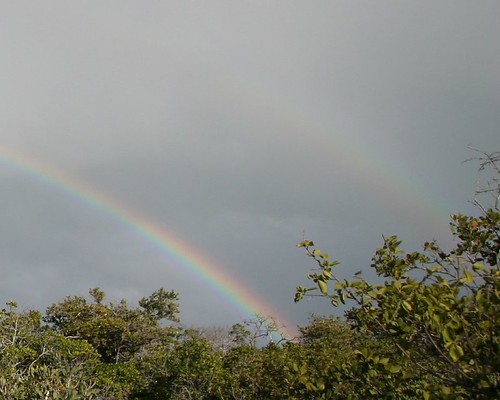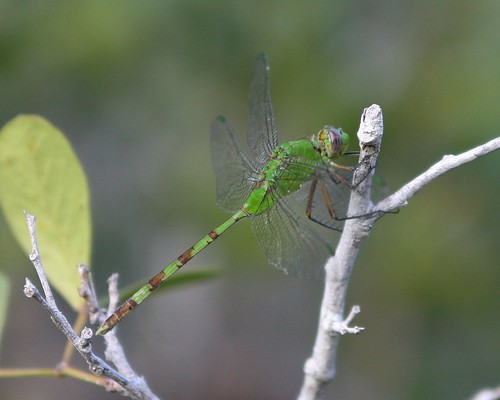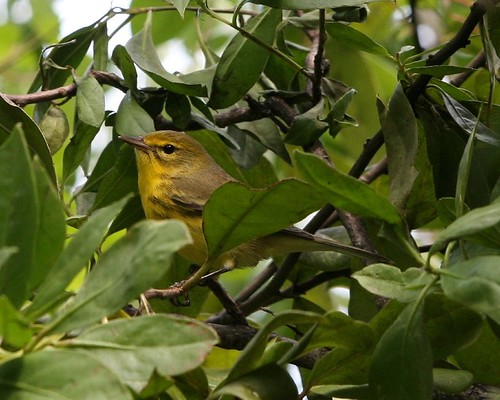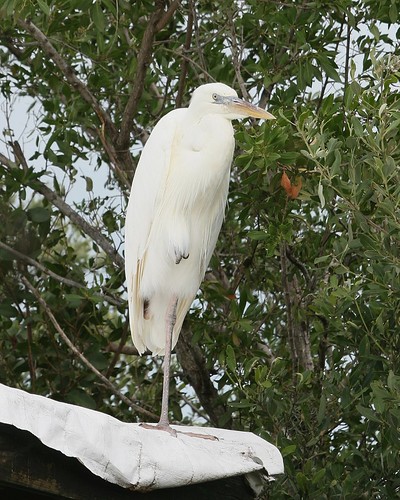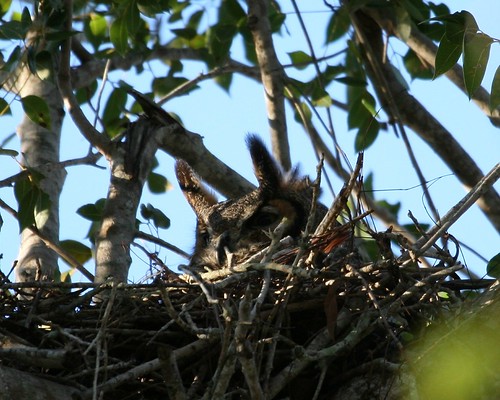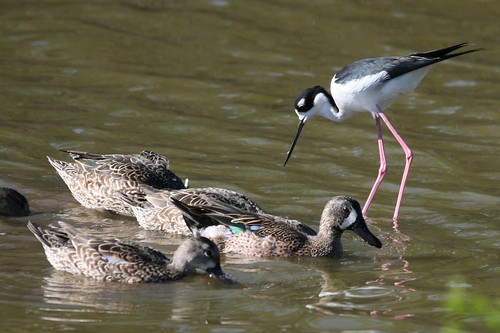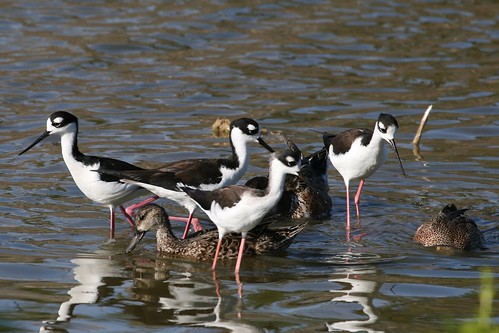Just after taking photos of the Great Pondhawk, we were concerned that we might get rained on by a nearby storm. The storm cloud was behind us as we walked, and we would occasionally take a peek over a shoulder to see if it was serious about overtaking us. Ahead of us, however, the sun was shining strong, and a few peeks later a rainbow had come into view. At that point, I forgot about possibly getting wet, and started thinking about photographic opportunity. I had never tried photographing a rainbow before, so I suspect there are a few things I could have done better. Regardless of my photographic success, it was a treat just seeing the rainbow.
Great Pondhawk
When Tammy and I decided to drive south into the keys, our intention was simply to drive until we decided it was time to turn around. About the furthest south we got was Long Key. Here we stopped at Long Key State Park and walked the "Golden Orb Trail". Since it was getting late in the day, bird activity was next to nothing. I think we only needed one hand to count the birds we noticed. On the other hand, this beautiful dragonfly patiently perched on a twig right next to the trail and graciously allowed me to snap a few photos.
[edit: nannothemis identified this as a Great Pondhawk.]
[edit: nannothemis identified this as a Great Pondhawk.]
Prairie Warbler
The Florida Keys Wild Bird Center also has another very short trail on the "road side" of the property (as opposed to the "ocean side"). This trail has no cages for injured or recuperating birds. It was simply a short walk through dense low trees. That may sound boring, but that short walk was sufficient for me to see three different species of warbler in about ten minutes. Even better, because the trees were so low, the warblers were never really very far away.
Seeing a warbler, even when they are not in full breeding plumage, is always a bit exciting to me. Their plumage feels out of the ordinary, and when I first see a flash of yellow or orange, I am immediately drawn to it. Even better, they are a challenge for me to photograph. They are very active birds, so catching one sitting still long enough, close enough, and with a clear enough line of sight can be a rare event. I have no shortage of photographs that are of the spot where a warbler was sitting just a moment ago, or a blurred image of a warbler flying out of frame, or a leaf or stick behind which the warbler is sitting. Patience and diligence will pay off, however, and I will eventually get a photograph that is worth sharing.
In this particular case, my target was a Prairie Warbler. He was not in full view, but it was enough of a view. And he was close. These photos are cropped from their respective originals, but I used my Tamron 28-75mm (at 75mm) instead of my usual Canon 100-400mm long lens.
Seeing a warbler, even when they are not in full breeding plumage, is always a bit exciting to me. Their plumage feels out of the ordinary, and when I first see a flash of yellow or orange, I am immediately drawn to it. Even better, they are a challenge for me to photograph. They are very active birds, so catching one sitting still long enough, close enough, and with a clear enough line of sight can be a rare event. I have no shortage of photographs that are of the spot where a warbler was sitting just a moment ago, or a blurred image of a warbler flying out of frame, or a leaf or stick behind which the warbler is sitting. Patience and diligence will pay off, however, and I will eventually get a photograph that is worth sharing.
In this particular case, my target was a Prairie Warbler. He was not in full view, but it was enough of a view. And he was close. These photos are cropped from their respective originals, but I used my Tamron 28-75mm (at 75mm) instead of my usual Canon 100-400mm long lens.
Snowy Egret
When I first starting writing my previous post, I had envisioned a larger comparison between white wading birds. I abandoned that idea once I realized the number of white waders for which I had no photograph: Cattle Egret, immature Little Blue Heron, white morph of Reddish Egret. And then I realized that I was ignoring several other birds, such as White Ibis, Wood Stork, immature Roseate Spoonbill and even Whooping Crane. This quickly overwhelmed my poor brain, and thus my previous post turned into the much simpler comparison of just two white waders.
I still, however, had this photograph of a Snowy Egret, also taken from the grounds of Florida Keys Wild Bird Center. There was a viewing area at the back of the grounds, and this Snowy Egret was perched in clear view, intent on some personal grooming.
The obvious field mark is the yellow feet. The black bill and legs are also important, especially when the feet are under water. More subtle marks are the yellow loral area (between the eye and bill), and the yellow lines down the back of the legs (barely visible in this photograph).
[edit: added missing word in last sentence of first paragraph]
I still, however, had this photograph of a Snowy Egret, also taken from the grounds of Florida Keys Wild Bird Center. There was a viewing area at the back of the grounds, and this Snowy Egret was perched in clear view, intent on some personal grooming.
The obvious field mark is the yellow feet. The black bill and legs are also important, especially when the feet are under water. More subtle marks are the yellow loral area (between the eye and bill), and the yellow lines down the back of the legs (barely visible in this photograph).
[edit: added missing word in last sentence of first paragraph]
Great White Heron
Back in January, Tammy and I were in south Florida for some college football, but also took some time to explore a bit. As my recent posts have described, we took one day to explore some of Everglades National Park. Another day trip, however was a drive south further down into the keys. One stop that we made on that drive was at the Florida Keys Wild Bird Center (FKWBC), located in Tavernier. Their primary purpose is to provide emergency and recuperative care for injured birds.
While exploring the FKWBC grounds I snapped photos of several of the injured birds, as well as several wild birds that were just hanging about the place. It wasn't until later, however, when I got a chance to review the photos, that I realized one of the large, white wading birds was not the Great Egret that I assumed it was. After flipping through several field guides, and doing some research on the Internet, I came to the conclusion that I had gotten a picture of a white morph Great Blue Heron (also known as Great White Heron).
The first field mark that my research pointed out was the color of the legs. Great Egret has black legs and Great White Heron has pale legs. Depending on the light, however, black legs might appear to be not quite black, but they are still much darker than the Great White Heron's pale legs. Next was the bill. The Great White Heron has a heavier bill than the Great Egret. To me, the Great White Heron looked like it had a regular Great Blue Heron's bill stuck on a white bird. Finally, the Great Egret may also have plumes trailing from its back and breast, while the Great White Heron would only have plumes trailing from its head. I suspect that there are other clues to help tell these two apart which I have not listed here.
Here are my photos. The first is the Great White Heron. The second is the Great Egret.
While exploring the FKWBC grounds I snapped photos of several of the injured birds, as well as several wild birds that were just hanging about the place. It wasn't until later, however, when I got a chance to review the photos, that I realized one of the large, white wading birds was not the Great Egret that I assumed it was. After flipping through several field guides, and doing some research on the Internet, I came to the conclusion that I had gotten a picture of a white morph Great Blue Heron (also known as Great White Heron).
The first field mark that my research pointed out was the color of the legs. Great Egret has black legs and Great White Heron has pale legs. Depending on the light, however, black legs might appear to be not quite black, but they are still much darker than the Great White Heron's pale legs. Next was the bill. The Great White Heron has a heavier bill than the Great Egret. To me, the Great White Heron looked like it had a regular Great Blue Heron's bill stuck on a white bird. Finally, the Great Egret may also have plumes trailing from its back and breast, while the Great White Heron would only have plumes trailing from its head. I suspect that there are other clues to help tell these two apart which I have not listed here.
Here are my photos. The first is the Great White Heron. The second is the Great Egret.
Great Horned Owl On Nest
While Tammy and I were in Everglades National Park, we heard from another visitor (who, in turn, had heard from a local birding club doing a Christmas Bird Count) of where we could see a Great Horned Owl sitting on a nest. I love seeing owls, so I wasn't going to miss the opportunity to see one on a nest. Tammy and I found the nest, but were later told by a park ranger not to advertise the location because the nest might get endangered.
At first I was thinking that the danger was simply too much human interest in the nest and the stress to the birds that would accompany the human traffic. But the park ranger explained that an owl's nest was a target for egg collectors. Egg collecting?
Okay. Obviously there was something here that I was (and still am) a bit naive about. A few Google searches later, however, and I have learned a new word: oology. The collection of wild bird eggs is an old hobby that evolved into something much more formal and science based. The collection of eggs, however, has some serious conflicts of interest. An egg taken for something as positive sounding as scientific study is an egg that will not hatch into a new generation, which puts even more pressure on a species that might need all the help it can get. Here is an article written for the October 2005 edition of Birder's World magazine that provides very good background on this subject. And here is a letter to the editor of a magazine called Birds and All Nature, published in May 1899 (yes...1899!) that provides a decidedly negative opinion of the collection of eggs. Ironically, the letter writer also states that collecting and mounting specimens of birds is not all that bad.
So, here is that Great Horned Owl sitting on her nest. I took this photo from an undisclosed located within Everglades National Park. Hopefully one more generation of owl will fledge from this nest.
At first I was thinking that the danger was simply too much human interest in the nest and the stress to the birds that would accompany the human traffic. But the park ranger explained that an owl's nest was a target for egg collectors. Egg collecting?
Okay. Obviously there was something here that I was (and still am) a bit naive about. A few Google searches later, however, and I have learned a new word: oology. The collection of wild bird eggs is an old hobby that evolved into something much more formal and science based. The collection of eggs, however, has some serious conflicts of interest. An egg taken for something as positive sounding as scientific study is an egg that will not hatch into a new generation, which puts even more pressure on a species that might need all the help it can get. Here is an article written for the October 2005 edition of Birder's World magazine that provides very good background on this subject. And here is a letter to the editor of a magazine called Birds and All Nature, published in May 1899 (yes...1899!) that provides a decidedly negative opinion of the collection of eggs. Ironically, the letter writer also states that collecting and mounting specimens of birds is not all that bad.
So, here is that Great Horned Owl sitting on her nest. I took this photo from an undisclosed located within Everglades National Park. Hopefully one more generation of owl will fledge from this nest.
Black-necked Stilt
About five years ago, I took a winter trip to southern Florida that included a few nights in Everglades National Park. I stayed in a cabin in Flamingo. This was when I first started getting into birdwatching, and before I even owned a DSLR camera. That trip to Florida was fantastic.
While in the Everglades during that trip, I would explore some trail of the park during the morning hours, and then return to my cabin mid-afternoon. After a bit of food and rest, I would then walk over to a place called Eco Pond to look for more birds, sometimes staying until it got too dark to see anything. Eco Pond was simply a half-mile hike around a pond that had a tree covered island in its middle. But there were alligators in the pond, and a large variety of birds to be seen.
When Tammy and I visited Everglades National Park this past January, we took time one day to drive all the way down to Flamingo and visit Eco Pond. Between my first trip a few years ago and this one, however, several hurricanes have blown across southern Florida. The then-and-now difference was dramatic: the cabins were gone, the hotel-like lodge at Flamingo was heavily damaged and deserted, the first viewing deck at Eco Pond was gone, and there were fewer trees. I remember seeing specific birds on my first trip in trees that were nowhere to be found on this trip.
A few posts back I shared a picture of an American Crocodile sunning itself on a board at Eco Pond. The photos below show Black-necked Stilts (and some Blue-winged Teals) snagging a convenient meal from Eco Pond. When I look at Flamingo and Eco Pond, I see radical changes relative to what I remember from a few years back. I wonder how the animal kingdom sees it?
While in the Everglades during that trip, I would explore some trail of the park during the morning hours, and then return to my cabin mid-afternoon. After a bit of food and rest, I would then walk over to a place called Eco Pond to look for more birds, sometimes staying until it got too dark to see anything. Eco Pond was simply a half-mile hike around a pond that had a tree covered island in its middle. But there were alligators in the pond, and a large variety of birds to be seen.
When Tammy and I visited Everglades National Park this past January, we took time one day to drive all the way down to Flamingo and visit Eco Pond. Between my first trip a few years ago and this one, however, several hurricanes have blown across southern Florida. The then-and-now difference was dramatic: the cabins were gone, the hotel-like lodge at Flamingo was heavily damaged and deserted, the first viewing deck at Eco Pond was gone, and there were fewer trees. I remember seeing specific birds on my first trip in trees that were nowhere to be found on this trip.
A few posts back I shared a picture of an American Crocodile sunning itself on a board at Eco Pond. The photos below show Black-necked Stilts (and some Blue-winged Teals) snagging a convenient meal from Eco Pond. When I look at Flamingo and Eco Pond, I see radical changes relative to what I remember from a few years back. I wonder how the animal kingdom sees it?
Tricolored Heron
Since my previous two posts have been about blue wading birds, I figured I would add a third (while I wait for Super Bowl XLII to resume play in the second half). I guess it is possible for the Tricolored Heron to get confused with either of the other two blue herons, but his white belly and the thin line of white up the front of his neck give him away. You can find Tricolored Heron pretty much all year long along the gulf coast and up the east coast to about North Carolina. I have seen them in eastern Virginia in the warmer months.
This photo is another from Anhinga Trail in Everglades National Park, taken last month. While the line of white up his neck is not visible here, his white belly is obvious.
This photo is another from Anhinga Trail in Everglades National Park, taken last month. While the line of white up his neck is not visible here, his white belly is obvious.
Subscribe to:
Posts (Atom)
